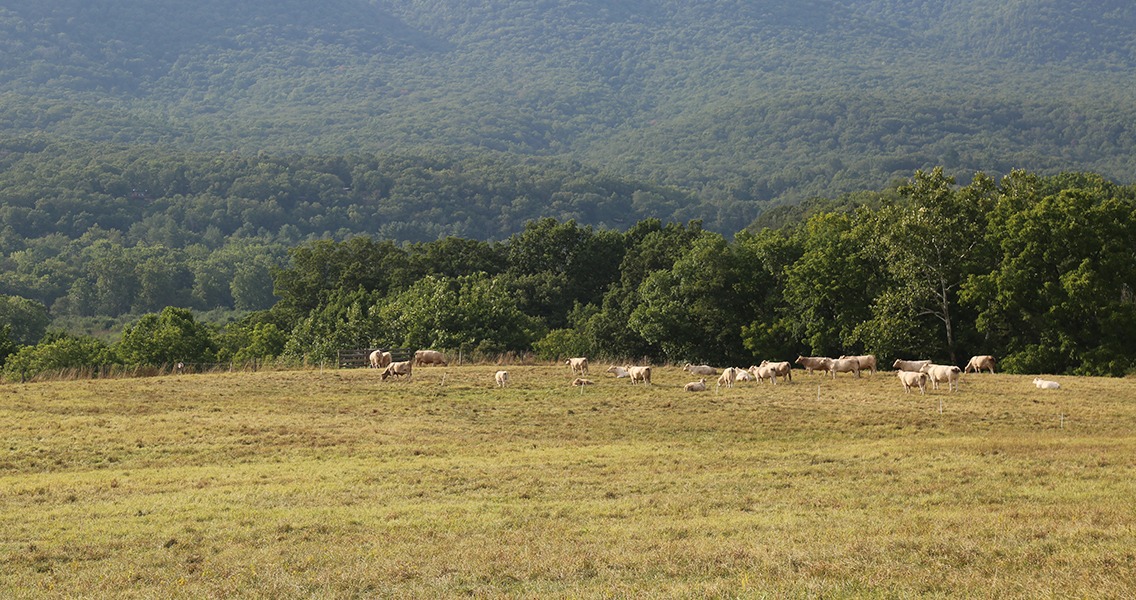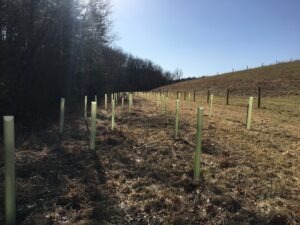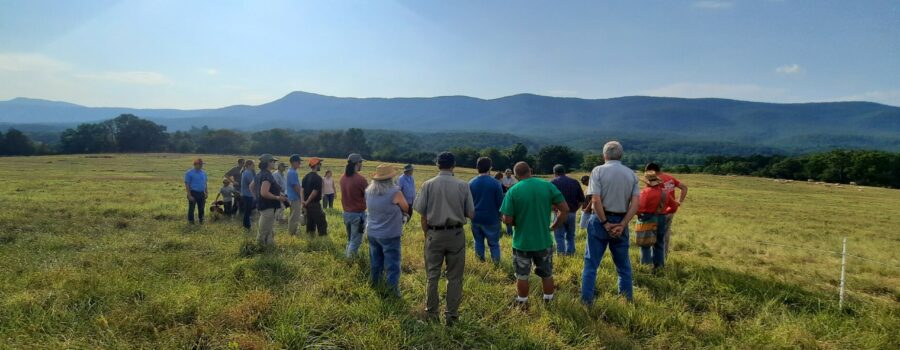L.M. Lawler Farm is situated in Page County on the bank of the South Fork of the Shenandoah River and is bisected by a tributary stream on its way to the big river. The Cumbia family have raised cattle here for generations, and in that time, they have grown and adapted their management so that their farm operates in concert with the resources they steward on their property. The result of their efforts are healthy soils, new stream-side forest habitats, a pristine stream, and happy cattle.
There is no doubt that making changes to how a farm is managed is a lift, but as you read on you’ll see, often the benefits are many. Here are several steps the Cumbias have taken to improve their farm, its soils, and the water that flows through it:

Innovative Fencing Design + Trees and Bushes Along Waterways
= Clean Water and a Healthy Herd
The Cumbias use temporary electric fencing to rotate their cattle through their pastures, making sure that the cows always have access to the best grass to eat. When their cows are along the river, they put up the fencing to keep the cows out of the water and off the riverbank. When it’s time to move the cows to a new pasture, they take the fencing down. This allows them to control where cattle are grazing without being concerned that a costlier permanent fence would be damaged or lost when the river floods.
They have also installed permanent fencing and hardened stream crossings, kind-of like a bridge, to keep cattle out of the stream that runs through the property. Fencing cattle out of streams and rivers, when coupled with another fresh water supply (more about that later), keeps both the stream and the herd healthy.
Once they determined the area along the stream and river that cattle would no longer have access to, then they planted lots of trees. Working with the Alliance’s very own Chris Anderson, wearing another hat, they planted 953 trees along the banks of the South Fork of the Shenandoah River (read Chris’ take on this work in the green box below)! Tree and shrub planting along waterways leads to cleaner water in several ways. First, the roots help to stabilize the streambank so soil doesn’t fall in and disrupt the rocky habitats at the bottom of the stream. Those same roots absorb pollutants from the water while the tree canopy provides shade and keeps the water cool for our native cold water aquatic species like brook trout.

Rotational Grazing + Soil Testing
= Productive, Carbon-rich Soil and More Abundant Food for Cattle
The Cumbia’s cattle graze on only a small portion of pasture at a time and then move to a new section of fresh pasture on a regular basis, so often in fact, that the cows are off a certain piece of land for more time than they are on it. This ‘time off’ for the grass allows it to generate healthy roots, pull carbon from the air and put it in the soil, and act like a sponge to absorb heavy rains, rather than letting that water run off to somewhere else. By keeping the grass growing, the Cumbias can save or ‘stockpile’ forage during the spring and fall when the grass is growing quickly so that the cows have forage during the hot, dry summer and coldest winter months when the pastures are growing slowly. This greatly reduces the need to make hay as the cattle have fresh pasture to consume almost year-round.
The Cumbia’s soil is well maintained by their grazing practice, but they also monitor their soils with regular testing, so if they need to add fertilizer, they can apply just the right amount. Plus, their grazing practices are known to take carbon from the atmosphere and trap it in the soil, which not only makes the grass grow better, but can also become another source of income through carbon credits that are purchased by corporations as they make their own transitions to more eco-friendly practices.

Dispersement of Water and Hay
= Dispersement of Concentrated Pollutants
and Fresh Water and Food for Cattle
A cow that is producing milk for her calf will drink 20 to 30 gallons of water on a hot summer day. When her only option is to get that water from a stream or river, she will spend a lot of time hanging out along that stream bank. A whole herd of thirsty cows leads to trampled banks and soil being pushed into the stream or river. All of that water she drinks eventually comes out and if the cow is standing in the stream when it does, her excrement goes directly into the streams or river, adding nutrients to the water that encourage growth of organisms and bacteria harmful to people and cows. Both the soil and the excrement in the water disrupt aquatic habitats and add to water bills as municipalities have to work harder to filter water before it gets to our drinking glass.
In addition to the fencing that we discussed earlier that keeps the cows out of the water, the Cumbias took advantage of programs with the Natural Resource Conservation Service and installed permanent watering stations in their pastures so that their cows always have fresh and clean water. On the worst winter days, when they have to feed hay, the Cumbias do so in different areas of the pastures. By spreading out where the cattle are drinking and eating, they ensure that the herd is spreading manure and nutrients around the pastures where it fertilizes the growing grass, rather than becoming concentrated in any particular spot on the farm.

Sharing Success
= More Profitable Farms and Cleaner Water in the Valley
Possibly the most important thing that the Cumbias do is generously share their time, inviting other farmers and neighbors to their farm to demonstrate and explain all the work they have done to improve their own farm and motivate other farmers to experiment with similar practices in their own operations.
Several of the Alliance’s partners in the Shenandoah Valley Conservation Collaborative had a hand in helping the Cumbia’s transition to new practices and tailoring them specifically to the Cumbia’s landscape and operation. So, from our perspective here at the Alliance, the Cumbias are leading the way for the future of conservation farming in the Valley.
 Chris, on planting trees
Chris, on planting trees
A tree planter for the last 22+ years, I am grateful for the opportunity to have worked on some of the most stunningly beautiful properties in the Shenandoah Valley, installing riparian buffers along streams, the Shenandoah River and ponds. These streamside forests benefit water quality by acting as anchors for the soil and as sponges by soaking up pollutants before they reach the waterways.
In this project on the Cumbia’s farm along the banks of the South Fork of the Shenandoah River, 935 recently-planted native trees and shrub seedlings now help stabilize the soil and will eventually help protect water quality and create habitat and provide food for wildlife.
Planted over the winter and early spring, the riparian buffer was paid for in part by government cost-share programs, including the Conservation Reserve Enhancement Program (CREP) and the Mountains to Bay Program sponsored by the Virginia Department of Forestry.
Regular rains have helped settle the rich bottomland soil and encouraged root growth of species such as river birch, sycamore, bald cypress, tulip poplar, red osier dogwood and buttonbush, among others. Plastic shelters help protect the seedlings from browsing deer and guard against burrowing mice and voles which like to nibble the bark.
It is thrilling to go back and visit projects and see the visible passing of time in the form of full forests with complete canopy cover. Birds sing amongst the branches, countless thousands of caterpillars feed happily on the leaves and the organic matter in the soil continues to improve year after year. I look forward to visiting that scene at the Cumbia’s farm years from now.
~ Chris Anderson
Chris is the Alliance’s Page and Warren Counties Coordinator, but also a professional tree planter!
Photos by Chris Anderson and Kevin Tate.

